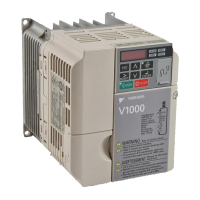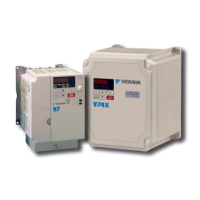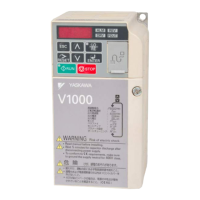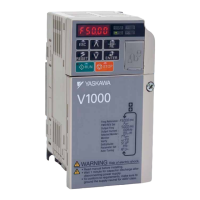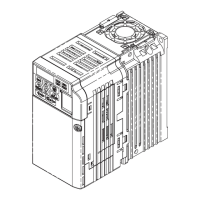3.6 Main Circuit Wiring
This section describes the functions, specifications, and procedures required to safely and properly wire the main circuit of the drive.
NOTICE: Do not solder the ends of wire connections to the drive. Soldered wiring connections can loosen over time. Improper wiring practices could result in drive malfunction due
to loose terminal connections.
u
Main Circuit Terminal Functions
Table 3.1 Main Circuit Terminal Functions
Terminal Type Function Reference
R/L1
Main circuit power supply input
Connects line power to the drive.
Drives with single phase 200 V input power use terminals R/L1 and S/L2 only (T/L3 must not be used).
36S/L2
T/L3
U/T1
Drive output Connects to the motor. 43V/T2
W/T3
B1
Braking resistor Available for connecting a braking resistor or the braking resistor unit option. 52
B2
+1
DC reactor connection
These terminals are shorted at shipment. Remove the shorting bar between +1 and +2 when connecting to this
terminal.
272
+2
+1
DC power supply input For connecting a DC power supply. -
–
(2 terminals)
Ground
Grounding Terminal
For 200 V class: 100 Ω or less
For 400 V class: 10 Ω or less
43
u
Wire Gauges and Tightening Torque
Select the appropriate wires and crimp terminals from
Table 3.2 through Table 3.4 .
Note: 1. Wire gauge recommendations based on drive continuous current ratings using 75°C 600 Vac vinyl-sheathed wire assuming ambient temperature within 30°C and wiring
distance less than 100 m.
2. Terminals +1, +2, –, B1 and B2 are for connecting optional devices such as a DC reactor or braking resistor. Do not connect other non-specified devices to these terminals.
• Consider the amount of voltage drop when selecting wire gauges. Increase the wire gauge when the voltage drop is greater than 2% of motor rated
voltage. Ensure the wire gauge is suitable for the terminal block. Use the following formula to calculate the amount of voltage drop:
•
Line drop voltage (V) =
3 x wire resistance (Ω/km) x wire length (m) x current (A) x 10
-3
• Refer to instruction manual TOBPC72060000 for braking unit or braking resistor unit wire gauges.
• Refer to UL Standards Compliance on page 353 for information on UL compliance.
n
Single-Phase 200 V Class
Table 3.2 Wire Gauge and Torque Specifications
Model
CIMR-VoBA
Terminal Screw Size
Tightening
Torque
N•m (lb.in.)
Applicable
Gauge
mm
2
(AWG)
Recommended
Gauge
mm
2
(AWG)
Line Type
0001
0002
0003
R/L1, S/L2, U/T1, V/T2, W/T3, –, +1, +2, B1,
B2,
M3.5
0.8 to 1.0
(7.1 to 8.9)
0.75 to 2.0
(18 to 14)
2.5
(14)
Note 1 on page
41
0006
R/L1, S/L2, U/T1, V/T2, W/T3, –, +1, +2, B1,
B2,
M4
1.2 to 1.5
(10.6 to 13.3)
2.0 to 5.5
(14 to 10)
2.5
(14)
Note 1 on page
41
0010
R/L1, S/L2, U/T1, V/T2, W/T3,
M4
1.2 to 1.5
(10.6 to 13.3)
2.0 to 5.5
(14 to 10)
4
(12)
Note 1 on page
41
–, +1, +2, B1, B2, M4
1.2 to 1.5
(10.6 to 13.3)
2.0 to 5.5
(14 to 10)
6
(10)
Note 1 on page
41
0012
R/L1, S/L2, U/T1, V/T2, W/T3, –, +1, +2, B1,
B2,
M4
1.2 to 1.5
(10.6 to 13.3)
2.0 to 5.5
(14 to 10)
6
(10)
Note 1 on page
41
0018
R/L1, S/L2, U/T1, V/T2, W/T3, –, +1, +2, B1,
B2,
M5
2 to 2.5
(17.7 to 22.1)
3.5 to 8
(12 to 8)
8
(8)
Note 1 on page
41
n
Three-Phase 200 V Class
Table 3.3 Wire Gauge and Torque Specifications
Model
CIMR-Vo2A
Terminal Screw Size
Tightening
Torque
N•m (lb.in.)
Applicable
Gauge
mm
2
(AWG)
Recommended
Gauge
mm
2
(AWG)
Line Type
0001
0002
0004
0006
R/L1, S/L2, T/L3, U/T1, V/T2, W/T3, –, +1, +2, B1,
B2,
M3.5
0.8 to 1.0
(7.1 to 8.9)
0.75 to 2.0
(18 to 14)
2
(14)
Note 1 on page
41
0010
R/L1, S/L2, T/L3, U/T1, V/T2, W/T3, –, +1, +2, B1,
B2
M4
1.2 to 1.5
(10.6 to 13.3)
2.0 to 5.5
(14 to 10)
2
(14)
Note 1 on page
41
M4
1.2 to 1.5
(10.6 to 13.3)
2.0 to 5.5
(14 to 10)
3.5
(12)
Note 1 on page
41
0012
R/L1, S/L2, T/L3, U/T1, V/T2, W/T3, –, +1, +2, B1,
B2,
M4
1.2 to 1.5
(10.6 to 13.3)
2.0 to 5.5
(14 to 10)
3.5
(12)
Note 1 on page
41
0020
R/L1, S/L2, T/L3, U/T1, V/T2, W/T3, –, +1, +2, B1,
B2,
M4
1.2 to 1.5
(10.6 to 13.3)
2.0 to 5.5
(14 to 10)
5.5
(10)
Note 1 on page
41
3.6 Main Circuit Wiring
YASKAWA ELECTRIC SIEP C710606 18A YASKAWA AC Drive – V1000 Technical Manual (Preliminary)
41
3
Electrical Installation

